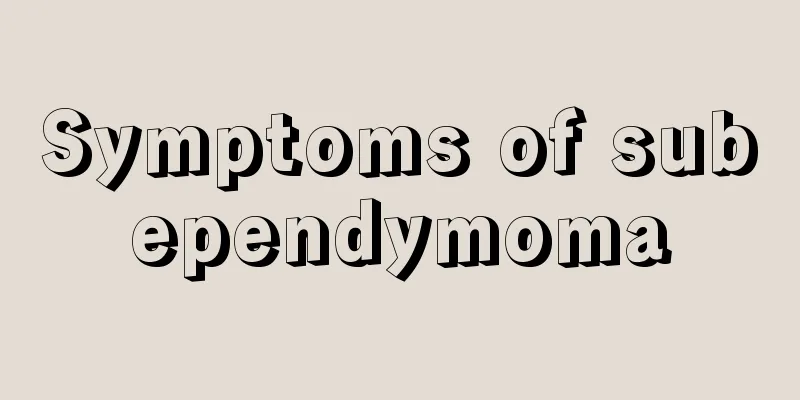Symptoms of subependymoma

|
Subependymoma is an uncommon disease in daily life. It can occur at any age, but is more common in young people, and more common in the fourth ventricle. It is a benign tumor, but once it worsens, it can cause great harm to the body. Therefore, it is particularly important to find scientific and effective treatment methods and early treatment. Friends in need can learn more about the relevant knowledge. 1. Subependymoma Subependymoma is a benign tumor that arises from subependymal cells, including subependymal glial cells, astrocytes, and ependymal cells. This is a rare tumor, accounting for less than 1% of all intracranial tumors. It can occur with ependymoma and is a sign of malignant transformation. It may occur in the lateral or fourth ventricle, adjacent to the lateral ventricular wall or septum pellucidum, or in the floor of the ventricle. The larger the lesion, the more likely it is to have cystic changes and calcifications. However, the calcifications are not as coarse and obvious as those in other intraventricular tumors and are usually fine punctate calcifications. Among asymptomatic patients, the average age of onset is 60 years, but if symptoms occur, the average age is 40 years. It is more common in males, and surgical resection is the common treatment, although complete resection of subependymoma in the fourth ventricle is a challenge. On CT, the tumor appears iso- or hypodense, and cystic changes and calcifications can be seen in larger lesions. If obstruction occurs, it is often accompanied by hydrocephalus. Enhanced scans usually show mild or no enhancement. On MR, the tumor shows high signal on T2/Flair sequence and isointense on T1 sequence, with mild or no enhancement. Since subependymomas of the fourth ventricle are more likely to be calcified and often enhanced on enhanced scans, their diagnosis is more challenging. Another common misdiagnosis is central neurocytoma, a recently recognized tumor that was previously misdiagnosed as intraventricular oligodendroglioma on histology. This tumor can show striking similarities to subependymoma on CT and MR imaging. However, CNS tumors more often enhance after enhancement and have more diverse cystic changes. It is also common in young people. 2. Differential Diagnosis Ependymoma: common in young people, with calcification, prone to occur in the fourth ventricle, and obvious enhancement. Although ependymomas can occur at any age and have no gender differences, they account for almost 30% of brain tumors in patients under 3 years old. It is more common in the posterior cranial fossa in children and supratentorial in young people. 60% of intraventricular ependymomas are found in the fourth ventricle. These soft tumors can extend through the foramen of Luschka into the cerebellopontine angle. Others are found in the lateral and third ventricles. Surprisingly, ependymomas have been reported to occur in the ovary, soft tissue, sacrococcygeal region, and mediastinum. Choroidal papilloma: A choroidal papilloma located in the choroid plexus, with obvious enhancement, rich blood vessels, and high density. It is more common in children and often causes hydrocephalus. On MRI, choroidal papilloma appears as a low-signal intraventricular mass on T1 sequences and a heterogeneous signal on T2 sequences. Common flow void signals reflect the rich vascularity of the tumor. Because distant implants are common, spinal cord imaging is often required. Central neurocytoma: seen in young adults (less than 40 years old), cystic masses with varying degrees of enhancement, arising from the lateral ventricular wall or septum pellucidum, tending to occur in the anterior horn of the lateral ventricle. 75% of patients are between 20 and 40 years old. It is a rare tumor, accounting for no more than 0.5% of all intracranial tumors. Meningioma: obvious enhancement, frequent calcification, common in women, if located within the ventricle, usually in the trigone of the lateral ventricle. Periparial edema may occur. Intraventricular meningiomas are relatively rare, accounting for less than 1% of all meningiomas, but are a relatively common intraventricular tumor in adults. Females are more likely to be affected, and nearly 20% of pediatric meningiomas occur in the ventricular system. |
<<: Minimally invasive surgery for esophageal leiomyoma
>>: Causes of Syringoma in the Corner of the Eye
Recommend
What types of prostate cancer are there
The male prostate is very fragile. If you don'...
Effects and precautions of Liuhuang soap
Many people like to use sulfur soap to wash their...
Age of onset of hereditary colorectal cancer
Colorectal cancer mainly includes colon cancer an...
What are the best treatments for vitiligo
Vitiligo is no longer uncommon in our lives. The ...
Summer fishing tips
It can be said that fishing is a leisure sport. M...
Is there anyone who doesn't need treatment for pituitary tumors for a lifetime?
Pituitary tumors are common intracranial tumors. ...
What are the causes of early tongue cancer
Chinese people often say to eat while it's ho...
Why do people with liver cancer have yellow skin
Liver cancer is a common malignant tumor in the d...
Will eating coriander cause miscarriage?
Coriander is a common vegetable in our daily life...
Why do I feel pain in my chest and back?
There are always waves of pain in the chest and b...
What's wrong with brown eyes
Normally, the eyes appear brown, which is a manif...
A bowl of water, cold and cough are all afraid of it
In autumn and winter, the number of patients suff...
Do books contain formaldehyde?
Many people now wonder whether there is formaldeh...
How to nourish hair
Some people's hair often becomes dry, split, ...
There are purple spots on the thighs
Purple spots suddenly appear on the thighs. Why d...









